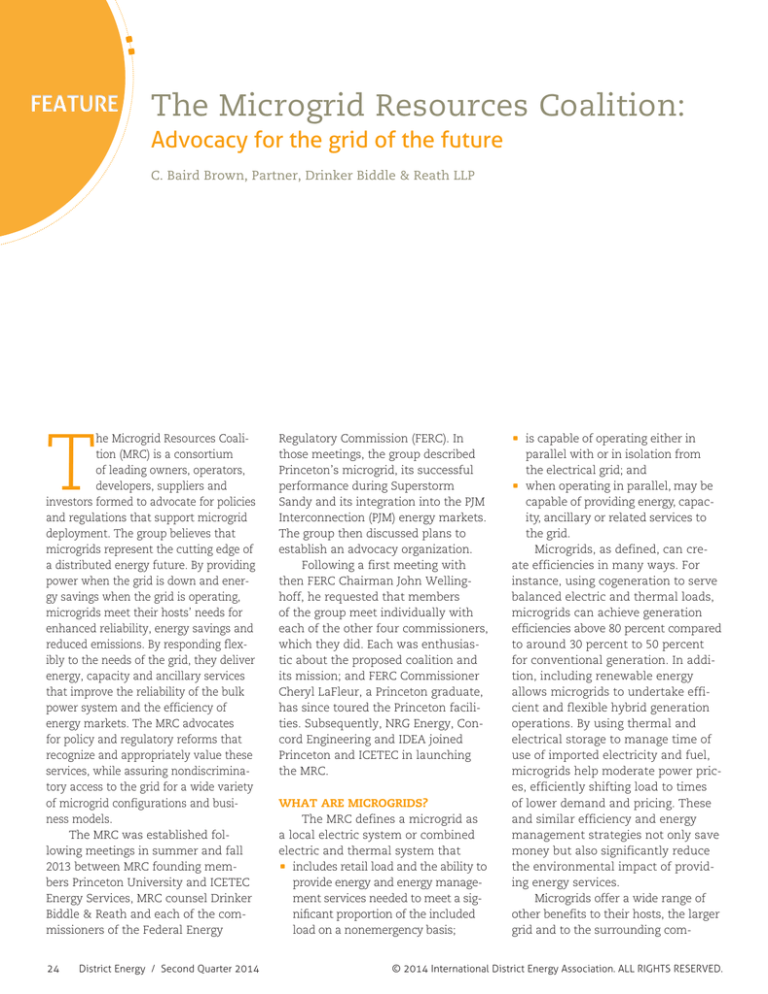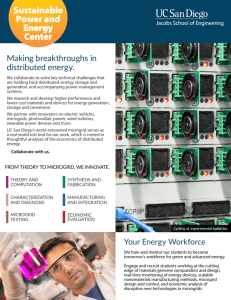
FEATURE
The Microgrid Resources Coalition:
Advocacy for the grid of the future
C. Baird Brown, Partner, Drinker Biddle & Reath LLP
T
he Microgrid Resources Coalition (MRC) is a consortium
of leading owners, operators,
developers, suppliers and
investors formed to advocate for policies
and regulations that support microgrid
deployment. The group believes that
microgrids represent the cutting edge of
a distributed energy future. By providing
power when the grid is down and energy savings when the grid is operating,
microgrids meet their hosts’ needs for
enhanced reliability, energy savings and
reduced emissions. By responding flexibly to the needs of the grid, they deliver
energy, capacity and ancillary services
that improve the reliability of the bulk
power system and the efficiency of
energy markets. The MRC advocates
for policy and regulatory reforms that
recognize and appropriately value these
services, while assuring nondiscriminatory access to the grid for a wide variety
of microgrid configurations and business models.
The MRC was established following meetings in summer and fall
2013 between MRC founding members Princeton University and ICETEC
Energy Services, MRC counsel Drinker
Biddle & Reath and each of the commissioners of the Federal Energy
24
District Energy / Second Quarter 2014
Regulatory Commission (FERC). In
those meetings, the group described
Princeton’s microgrid, its successful
performance during Superstorm
Sandy and its integration into the PJM
Interconnection (PJM) energy markets.
The group then discussed plans to
establish an advocacy organization.
Following a first meeting with
then FERC Chairman John Wellinghoff, he requested that members
of the group meet individually with
each of the other four commissioners,
which they did. Each was enthusiastic about the proposed coalition and
its mission; and FERC Commissioner
Cheryl LaFleur, a Princeton graduate,
has since toured the Princeton facilities. Subsequently, NRG Energy, Concord Engineering and IDEA joined
Princeton and ICETEC in launching
the MRC.
WHAT ARE MICROGRIDS?
The MRC defines a microgrid as
a local electric system or combined
electric and thermal system that
includes retail load and the ability to
provide energy and energy management services needed to meet a significant proportion of the included
load on a nonemergency basis;
··
capable of operating either in
··isparallel
with or in isolation from
the electrical grid; and
when operating in parallel, may be
capable of providing energy, capacity, ancillary or related services to
the grid.
Microgrids, as defined, can create efficiencies in many ways. For
instance, using cogeneration to serve
balanced electric and thermal loads,
microgrids can achieve generation
efficiencies above 80 percent compared
to around 30 percent to 50 percent
for conventional generation. In addition, including renewable energy
allows microgrids to undertake efficient and flexible hybrid generation
operations. By using thermal and
electrical storage to manage time of
use of imported electricity and fuel,
microgrids help moderate power prices, efficiently shifting load to times
of lower demand and pricing. These
and similar efficiency and energy
management strategies not only save
money but also significantly reduce
the environmental impact of providing energy services.
Microgrids offer a wide range of
other benefits to their hosts, the larger
grid and to the surrounding com-
··
© 2014 International District Energy Association. ALL RIGHTS RESERVED.
Photo Kate Awtrey.
Representatives of the Microgrid Resources Coalition participated in a panel discussion at IDEA’s 27th Annual Campus Energy Conference in February in Atlanta.
From left to right are Chris Berendt, Drinker Biddle & Reath; Tom Nyquist, Princeton University; Joseph Sullivan, Concord Engineering; Mike Webster, ICETEC; Ted
Borer, Princeton University; C. Baird Brown, Drinker Biddle & Reath; and John Webster, ICETEC.
munity. By “islanding” from the grid
in emergencies, a microgrid can both
continue serving its included load and
serve its surrounding community by
providing a platform to support critical
services – from hosting first responders and governmental functions to
providing key services and emergency
shelter. Microgrids can make it feasible to place generating capacity in
congested areas of the grid and, from
a planning perspective, can reduce
contingencies that threaten grid stability. Using electric and thermal storage
capabilities, a microgrid can provide
local management of variable renewable generation, particularly on-site
solar. Through fine-tuning its own
generation and load, a microgrid can
provide load following and other ancillary services to the grid in response to
real-time signals. Moreover, microgrids
are capable of providing energy and
multiple ancillary services at the same
time. Local microgrid service providers
make the operation of the grid more
competitive.
As a fundamental complication,
microgrids face often-conflicting
regulation at the federal, state and
sometimes local levels. As FERC
has recognized, even though they
are generally located behind the
meter on the distribution system,
microgrids provide services that substitute for and compete with the services of wholesale generation. They
generally purchase power at retail
rates, either from utilities or, where
allowed, competitive load-serving
entities that are regulated by state
public utility commissions (PUCs),
and they sell power and other services at wholesale rates subject to FERC
jurisdiction.
BARRIERS TO IMPLEMENTATION
Despite their many advantages,
microgrids face significant barriers
to widespread implementation.
FERC rules for the wholesale
electric markets under its jurisdiction were designed for a world divided into generation and load. Having
A S A F U NDA M E NTA L
C O M P L ICATIO N, M ICRO GRID S
FAC E O F TE N-CO NFLICTING
R E G UL ATIO N AT THE FE D E RA L,
S TAT E A ND S O M E TIM E S LO CA L
L E V E L S.
© 2014 International District Energy Association. ALL RIGHTS RESERVED.
a load resource capable of flexible
real-time response bends the rules.
FERC is working to recognize and
compensate some microgrid services
in the wholesale markets, including
demand response and frequency
regulation. Even in these markets,
however, tariffs do not adequately
categorize or compensate microgrids
for providing dynamic response and
capacity, for reducing congestion or
for contributing to reliability. Outside of FERC regulated markets, the
contributions of microgrids to the
balancing of the generation, transmission and distribution systems
go unrecognized.
State energy regulation imposes
more fundamental barriers to microgrids. In some states it is impossible
for an independent developer to provide energy generation services to
a single customer on the customer’s
own site, and in most states it is
impossible to aggregate retail load
from multiple customers into a
microgrid. Some states and municipalities also restrict retail distribution of thermal energy. Even in states
with retail deregulation, load-serving
entities generally must provide
energy on an all-or-nothing basis.
District Energy / Second Quarter 2014
25
Community choice aggregation legislation, virtual net metering and, in a
few states, specific microgrid support
legislation are the exceptions. As a
result, most sophisticated microgrid
development has occurred on campuses, such as universities or private
research facilities, where a single end
user is the microgrid host.
Finally, utility rate regulation in
most states discourages distribution
companies and integrated utilities
from supporting microgrid development. For the most part, these
utility companies are compensated
on the basis of the total number of
megawatt-hours they deliver, and a
reduction in retail demand through
energy efficiency or distributed
generation threatens their business
model. Distribution networks play a
critical role in supporting customer
microgrids and eventually can contribute to integration of multiple
microgrids into more self-healing,
resilient regional electric systems.
The Microgrid Resources Coalition
supports nondiscriminatory compensation for all services provided to
and by microgrids, and it supports
investment incentives for linking
microgrids into the grid of the future.
Without new business models that
reward distributed energy resources
while also maintaining the financial
viability of the distribution system,
the promise of microgrids will not
be achieved.
TAKING ACTION TO PROMOTE
GROWTH
The coalition will seek to promote microgrid industry growth
through fair and broad-based regulation. MRC advocacy before FERC,
state PUCs, regional transmission
organizations (RTOs) and the North
American Electric Reliability Corp.
will pursue a range of goals including
defining the microgrid resource in
the context of federal and state
regulatory schemes, and defining
the services provided by and to
microgrids, in order to seek parity
for resources with similar capabilities and nondiscriminatory treatment where microgrids can provide
equivalent performance;
establishing the basis for reasonable tariffs that do not discriminate between wires and generation
and among end users, distribution companies and independent
developers to the extent that they
provide equivalent reliability and
adequacy services;
··
··
and incentivizing
··implementing
integrated reliability planning
that accommodates the interests
of private-sector and regulated
infrastructure investors, state and
federal regulators, and stakeholders; and
supporting local governments
in their efforts to achieve more
resilient and cost-effective energy
infrastructure.
The coalition will pursue these
goals through working groups and
initiatives formed by interested members. MRC has formed a Wholesale
Markets Working Group to examine
issues arising in the wholesale markets operated under FERC jurisdiction by RTOs. While initially focused
on RTO markets, MRC expects that
by clearly identifying the value of
microgrids to the bulk power system,
it will be able to facilitate conversations with utilities and regulators
in traditionally regulated jurisdictions as well. The Wholesale Markets
Working Group is currently undertaking a review of recent actions by
the PJM Interconnection to amend
its manuals so as to limit participation by flexible demand response
resources such as microgrids in
PJM’s economic demand response
··
Courtesy Ted Borer.
Courtesy Princeton University.
In the wake of Superstorm Sandy, Princeton University’s 15 MW cogeneration plant was able to power
the campus by disconnecting from the local electric utility and running in island mode. Princeton is one
of the founding members of the Microgrid Resources Coalition.
26
District Energy / Second Quarter 2014
Ted Borer, Princeton University energy
plant manager and Microgrid Resources
Coalition member, outside the Federal Energy
Regulatory Commission headquarters in
Washington, D.C.
© 2014 International District Energy Association. ALL RIGHTS RESERVED.
program. (See sidebar.) The coalition
has also formed a State Regulation
Working Group both to support PUCs
seeking to encourage deployment of
microgrids and to work to remove
regulatory barriers to widespread
deployment. MRC expects to form
additional working groups, including
a group on reliability planning, as it
goes forward.
The Microgrid Resources Coalition aims to expand the conversation
about the future of energy delivery
systems. It wants to encourage resiliency by acting locally to meet local
needs. But MRC also expects to help
shape the larger discussion about the
grid of the future, both through public
education and through focused regulatory advocacy on behalf of microgrid
resources. The coalition invites members of the emerging microgrid sector
to join it in taking action.
A PROBLEM AT PJM
More information is available at
www.microgridresources.com
C. Baird Brown is a partner in Drinker
Biddle & Reath LLP’s Environment and
Energy Practice Group. His practice
includes the development and financing
of energy and sustainable infrastructure
projects, and he also advises on regulatory and policy issues affecting such
projects. He is counsel to the Microgrid
Resources Coalition. Brown began his
legal career in the Office of General
Counsel of the Board of Governors of the
Federal Reserve System. He is a former
co-chair of American Bar Association and
International Bar Association committees
on renewable and distributed energy-related issues. He holds a Juris Doctor degree
from the University of Pennsylvania Law
School and a Bachelor of Arts from the
State University of New York at Buffalo.
ORDER
745
In its Order 745, FERC directed regional transmission organizations
to establish demand response markets open to retail load with included
generation or the ability to curtail electric demand. FERC established two
criteria for demand resources to participate: A demand resource must
have the technical ability to respond to grid signals, and its participation
must provide a net benefit to the grid – reducing price after taking load
reduction into account.
PJM Interconnection initially implemented Order 745 in a way that
permitted microgrids and other flexible behind-the-meter generation to
participate. However, in recent action PJM has amended its manuals to
severely limit microgrid participation by imposing a new test that rejects
compensation for resources when they have additional financial motivations to participate. MRC and PJM member ICETEC, with assistance from
MRC counsel Drinker Biddle, objected that the proposed changes violated
Order 745. In a letter shared with PJM stakeholders, they quoted FERC’s
order: “In the absence of market power concerns, the Commission does
not inquire into the costs or benefits of production for the individual
resources participating as supply resources in the organized wholesale
electricity markets and will not here … single out demand response
resources ….”
PJM’s stakeholders voted not to support the proposed changes, but
PJM has moved to implement them anyway. ICETEC estimates that revenues available for flexible demand response resources participating in
this market will decrease by 30 percent to 60 percent as a result of these
changes. The MRC Wholesale Markets Working Group is evaluating possible MRC action on this issue.
Thermal Energy
Storage Tanks
7600�TON-HOUR�THERMAL�
ENERG��STORAGE�TANK
INDIAN�RIVER�STATE�COLLEGE�-�
PRUITT�C AMPUS
�
MATERN�PROFESSIONAL�
ENGINEERING,�INC .�&
DONADIO�&�ASSOCIATES,
ARCHITECTS,�P.A .
With the addition of a CROM
thermal energy storage tank,
the college has fully shifted
their cooling loads to the
evening hours. In doing so,
they are taking advantage of
substantially lower cost per
kilowatt “off-peak” rates and
reduced demand charges.
In addition, their power
provider rewarded this green
initiative with a generous
rebate to apply to the cost of
construction.
R
Designers and
Builders of Virtually
Maintenance-Free
Prestressed
Concrete Tanks
Since 1953
THE CROM
CORPORATION
250 S.W. 36TH TERRACE
GAINESVILLE, FL 32607
PHONE: (352) 372-3436
www.cromcorp.com
© 2014 International District Energy Association. ALL RIGHTS RESERVED.
District Energy / Second Quarter 2014
27







